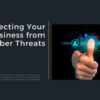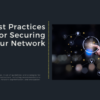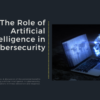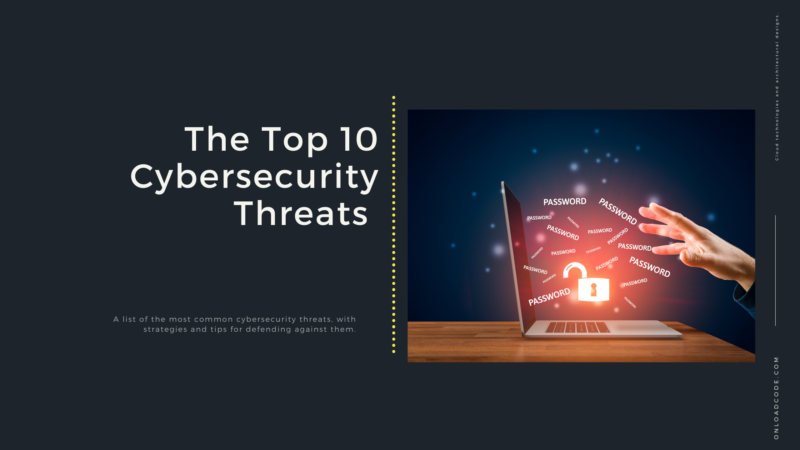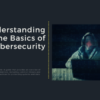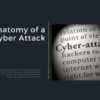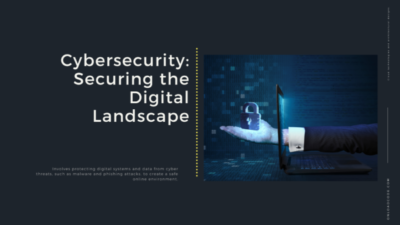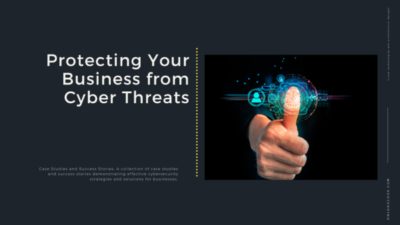This article will provide an overview of the top 10 cybersecurity threats that individuals and organizations face today, including malware, phishing attacks, and ransomware. It will also offer practical tips and strategies for defending against these threats and protecting sensitive information.
This is the 2nd article on the Cybersecurity: Securing the Digital Landscape series. In this article, we are discussing the Top 10 Threats in Cybersecurity.
Introduction
The threat landscape of cybersecurity is constantly evolving, making it challenging for individuals and organizations to stay ahead of potential risks. New vulnerabilities and attack vectors are being discovered all the time, and attackers are becoming increasingly sophisticated in their methods.
One example of this is the rise of ransomware attacks in recent years. Ransomware is a type of malicious software that encrypts a victim’s files and demands payment in exchange for the decryption key. These attacks can have devastating consequences for individuals and businesses, causing significant financial losses and reputational damage.
Another example is the prevalence of phishing attacks, which are designed to trick individuals into divulging sensitive information such as passwords and credit card numbers. Phishing attacks can take many forms, including fake login pages, fraudulent emails, and social media scams.
As the use of technology becomes more widespread and complex, the threat landscape of cybersecurity will continue to evolve. It is crucial for individuals and organizations to stay informed about the latest threats and best practices for protecting against them.
The Top 10 Cybersecurity Threats
In today’s world, the digital landscape is constantly evolving, and so are the cyber threats. It’s crucial to stay informed about the various types of cyber threats that can compromise your sensitive information and data. In this section, we’ll take a closer look at the top 10 cybersecurity threats and explore effective ways to defend against them.
Phishing Attacks: How to Recognize and Avoid Them
Phishing is a social engineering attack that targets users to gain access to their sensitive information. It’s often delivered via emails, instant messages, or social media platforms, tricking users into divulging their login credentials or other personal data. Cybercriminals can then use this information for various purposes, including identity theft or financial fraud. To defend against phishing attacks, you should always be vigilant about suspicious messages and links and avoid providing your personal information.
Examples :
- Fake emails that appear to be from a legitimate source asking for sensitive information, such as usernames and passwords
- Phishing websites that impersonate a legitimate website in order to steal login credentials
- Spear phishing, where attackers target specific individuals or organizations with personalized and convincing messages
Malware: Types, Symptoms, and Prevention Measures
Malware is a type of malicious software that is designed to harm your computer system or network. It includes various forms of software, such as viruses, Trojans, worms, and spyware, that can damage your system, steal your sensitive information, or even take over your computer. To protect against malware, you should use antivirus software, avoid downloading files from untrusted sources, and keep your operating system and software up to date.
Examples :
- Viruses that infect and spread through files and software
- Trojan horses that appear to be legitimate software but contain hidden malicious code
- Ransomware that encrypts your files and demands payment in exchange for the decryption key
Ransomware: The Anatomy of a Devastating Attack
Ransomware is a type of malware that encrypts your files or blocks your access to your system and demands payment to restore your access. It can cause significant harm to your system and can lead to data loss or theft. To defend against ransomware, you should regularly back up your data, use strong passwords, and be cautious of suspicious emails or links.
Examples :
- WannaCry ransomware that infected over 200,000 computers in 150 countries in 2017
- NotPetya ransomware that caused billions of dollars in damages to companies such as Maersk and FedEx
- Ryuk ransomware that targeted hospitals during the COVID-19 pandemic
Insider Threats: Protecting Against Your Own Employees
Insider threats refer to cybersecurity risks that come from within your organization, such as employees, contractors, or vendors. They can intentionally or unintentionally cause damage to your systems or steal your sensitive data. To mitigate insider threats, you should implement access controls, perform background checks on employees, and educate your employees about cybersecurity best practices.
Examples :
- Employees with access to sensitive information who intentionally leak or steal it
- Accidental insiders who unknowingly compromise security through negligence or human error
- Third-party contractors or vendors with access to your systems who can also pose an insider threat
Advanced Persistent Threats (APTs): Stealthy and Persistent Attacks
APTs are sophisticated cyber attacks that are designed to target specific organizations or individuals. They involve a long-term and persistent effort to gain access to sensitive information and often use multiple attack vectors, such as malware and social engineering. To defend against APTs, you should use multi-factor authentication, conduct regular security audits, and implement network segmentation.
Examples :
- Nation-state attacks that use sophisticated techniques to gain access to sensitive information
- APT groups that operate in stealth mode for extended periods of time in order to exfiltrate data
- Fileless APTs that reside only in memory and leave no trace on disk, making them harder to detect
DDoS Attacks: Disrupting Your Online Services
DDoS (Distributed Denial of Service) attacks are designed to disrupt the normal functioning of your online services by overwhelming your system with traffic from multiple sources. They can cause significant damage to your business by disrupting your operations, damaging your reputation, or even causing financial losses. To defend against DDoS attacks, you should use traffic filtering, implement intrusion detection systems, and use content delivery networks (CDNs).
Examples :
- Mirai botnet that infected IoT devices to launch DDoS attacks on DNS provider Dyn in 2016
- GitHub’s DDoS attack that peaked at 1.3 terabits per second in 2018
- SYN flood attacks that overwhelm a target’s network with TCP connection requests
Social Engineering: Tricks and Deceptions to Steal Your Data
Social engineering is a tactic used by cybercriminals to manipulate people into divulging their sensitive information or performing certain actions. It can take various forms, such as phishing, pretexting, or baiting, and often targets human vulnerabilities, such as trust or fear. To defend against social engineering, you should educate your employees about common scams and attacks, use strong passwords, and be cautious of suspicious messages or links.
Examples :
- Baiting attacks that offer a false reward in order to entice users to click on a link or download a file
- Pretexting attacks that use a fake identity or story to trick users into divulging sensitive information
- Quid pro quo attacks that promise a benefit in exchange for information or access
Cryptojacking: Using Your Computing Power for Malicious Purposes
Cryptojacking is the unauthorized use of someone else’s computer to mine cryptocurrency. Attackers secretly install cryptocurrency mining software on victim’s devices, taking advantage of their processing power and electricity to mine cryptocurrency without the victim’s knowledge. This can cause a significant drain on the victim’s device and result in slower performance.
Cryptojacking attacks can occur through various methods, such as phishing emails or malicious websites that prompt users to download and install the mining software. To prevent cryptojacking, users should keep their software up-to-date, avoid clicking on suspicious links or downloading unknown files, and use reputable antivirus software.
Examples :
- Malicious JavaScript code that runs in the background of a website and uses a visitor’s CPU to mine cryptocurrency
- Cryptomining malware that infects computers and uses their processing power to mine cryptocurrency
- Cryptojacking botnets that infect thousands of devices to mine cryptocurrency on a large scale
Zero-Day Exploits: Vulnerabilities That Haven’t Been Patched Yet
A zero-day exploit is a vulnerability in software that has not been discovered or patched yet. Attackers can exploit these vulnerabilities to gain access to a system or network and carry out malicious activities, such as stealing sensitive data or installing malware.
Zero-day exploits can be difficult to detect, and they are often used in targeted attacks against specific organizations or individuals. To prevent zero-day exploits, users should keep their software up-to-date and use security solutions that include zero-day protection.
Examples :
- The Heartbleed bug that affected OpenSSL and compromised the security of millions of websites
- The EternalBlue exploit that was used to spread WannaCry ransomware
- The Meltdown and Spectre vulnerabilities that affected nearly all modern processors
IoT Threats: Securing Your Connected Devices
The Internet of Things (IoT) is a rapidly growing network of interconnected devices, from smartphones and smart homes to medical devices and industrial control systems. These devices can be vulnerable to a range of attacks, including DDoS attacks, malware infections, and unauthorized access.
To protect IoT devices, users should change default passwords, keep software up-to-date, and avoid connecting to unsecured networks. Additionally, users should be aware of the potential risks of IoT devices, such as privacy violations and data breaches.
Examples :
- Botnets that infect IoT devices and use them for DDoS attacks or cryptojacking
- Vulnerabilities in IoT devices that can be exploited to gain access to your network
- Poorly secured IoT devices that can be used as an entry point for attackers to compromise other devices on your network
The ever-changing threat landscape of cybersecurity requires constant vigilance and proactive measures to protect against a variety of threats. By understanding and taking steps to defend against the top 10 cybersecurity threats, individuals and organizations can better safeguard their data and systems from potential attacks.
Defending Against Cybersecurity Threats
To protect against cybersecurity threats, it’s crucial to implement a comprehensive defense strategy. Here are some best practices and tools to help defend against the top 10 cybersecurity threats:
Best Practices for Cyber Hygiene
Practicing good cyber hygiene is the first line of defense against cyber attacks. This includes regularly updating software and systems, using strong and unique passwords, and avoiding suspicious links or attachments in emails.
Using Security Frameworks and Industry Standards
Adopting security frameworks and industry standards, such as the NIST Cybersecurity Framework or ISO 27001, can help establish a baseline for cybersecurity and ensure that best practices are being followed.
Educating Your Employees and Raising Awareness
Employees are often the weakest link in cybersecurity, so it’s important to educate them on the risks and how to avoid them. This can include regular training sessions, phishing simulations, and awareness campaigns.
Implementing Multi-Factor Authentication and Access Controls
Multi-factor authentication and access controls, such as role-based access control and least privilege, can help prevent unauthorized access and limit the damage if a breach does occur.
Conducting Regular Risk Assessments and Audits
Regular risk assessments and audits can help identify vulnerabilities and ensure that security measures are effective and up to date.
Monitoring Your Network and Systems for Anomalies
Monitoring your network and systems for unusual activity can help detect and respond to attacks before they can do serious damage.
Keeping Your Software and Systems Up to Date
Keeping software and systems up to date is critical to ensuring that known vulnerabilities are patched and that security measures remain effective.
Investing in Cyber Insurance
Cyber insurance can provide financial protection in the event of a data breach or cyber attack, helping to cover the costs of recovery and mitigating the impact on your business.
By implementing these best practices and tools, you can help defend against the top 10 cybersecurity threats and reduce the risk of a damaging attack. Remember, cybersecurity is an ongoing process that requires vigilance and continuous improvement to stay ahead of the evolving threat landscape.
Conclusion
In today’s world, cybersecurity threats are constantly evolving and increasing in frequency, sophistication, and impact. No one is immune to the threat of cyber attacks, whether you are an individual, a small business, or a large corporation. It is essential to understand the top cybersecurity threats and take proactive measures to defend against them.
By being aware of the different types of cyber attacks, such as phishing, malware, ransomware, insider threats, APTs, DDoS attacks, social engineering, cryptojacking, zero-day exploits, and IoT threats, you can better defend against them. For example, you can educate yourself and your employees on how to recognize and avoid phishing emails, implement multi-factor authentication and access controls, keep your software and systems up to date, and invest in cyber insurance to mitigate the financial impact of a cyber attack.
Additionally, following best practices for cyber hygiene and using security frameworks and industry standards can go a long way in protecting your data and systems. Conducting regular risk assessments and audits and monitoring your network and systems for anomalies can also help you identify potential vulnerabilities and address them before they are exploited.
It is essential to remember that cybersecurity is an ongoing process and requires constant vigilance and attention. By being prepared and taking proactive measures to defend against cybersecurity threats, you can help safeguard your sensitive information and protect yourself from financial loss and reputational damage.

